Sep 01 - New 'MacRumors: Mac News and Rumors - All Stories' feed email from feed2email.net
Hi there!
Here's the latest feed from MacRumors: Mac News and Rumors - All Stories.

Add feeds@feed2email.net to your contact list to make sure you receive all your emails
Make sure to visit feed2email.net to get more feeds sent to your inbox.
To find out which feeds you are subscribed to, or to get further help, just reply to this email.
iOS developer David Barnard has written an interesting piece on App Store pricing, and whether freemium is the inevitable pricing model for iOS apps, or if there is another model that hasn't been considered yet.
The full piece is worth a read for anyone involved in app development or marketing, but an excerpt is below.
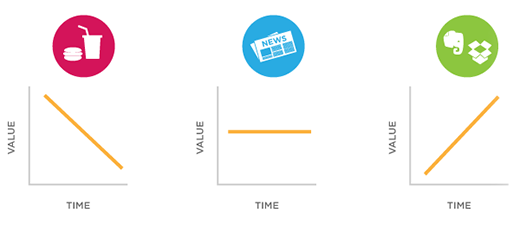
Chart created by Nate Weiner
Barnard continues:

Continuing its trailblazing efforts to deliver a great baseball viewing experience to iOS device owners, MLB Advanced Media has added Ford SYNC integration and social sharing with Facebook, Twitter, and email to its MLB.com At Bat app.
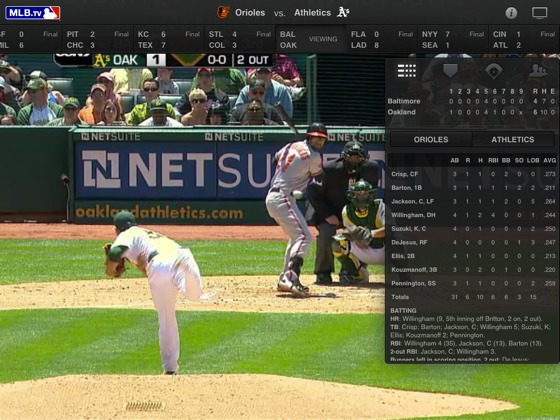
Ford SYNC is a Siri-esque integrated voice control system built into some Ford automobiles. The At Bat integration allows users to get scores, schedules, and live audio broadcast feeds using their voice.
At Bat 12 can be purchased for the remainder of the 2012 season for $9.99 (via in-app purchase), delivering out-of-market baseball games and home-and-away radio broadcasts for every game, including the postseason.
MLB At Bat is a free universal download from the App Store for iPhone and iPad. [Direct Link]
Reuters reports that retail giant Walmart is currently testing a new "Scan & Go" service at one Arkansas store that allows iPhone users to scan items with their device as they shop and then proceed to a self-checkout station on their way out of the store to complete their purchase. The report points to a survey Walmart is using to gather feedback on the initiative.
Walmart's test sessions were held earlier this week, with participants being compensated with a $100 payment and a $25 Walmart gift card for the one-hour sessions.
Details on how exactly the purchasing process works remain scant, but allowing users to scan their entire orders before approaching the checkout stand could in many cases result in significant time savings during busy shopping periods.
The biggest change in the rumored new iPhone is the increase in screen size from 3.5" to 4". As we've seen in numerous part leaks, the new iPhone screen will be taller, but not wider. This will give the new device a resolution of 1136x640 and provide apps with more vertical space to use. In fact, it's been found that iOS 6's home screen already supports this larger size to display an extra row of app icons.
In order to provide a better demonstration of what a 4" iPhone screen would feel like, MacRumors has had this video created to show it in action:
The video shows how the new 4" Home Screen would look. The extra space would naturally allow for larger app folder sizes. Games and other apps would have to be modified to take advantage of the extra real estate. We imagined, however, that existing apps would be "letterboxed", simply leaving empty black space at the top and bottom of the larger screen. Apple used a similar approach when supporting iPhone apps on the iPad.
The new 1136x640 resolution is almost exactly the same 16:9 ratio found on many widescreen monitors and televisions. This will fit many widescreen movies more naturally.
Some of the behavior in the video is speculative, but we believe it is likely representative of how a 4" iPhone would work. The evidence of such a screen has been overwhelming with part leaks and evidence of iOS support. Apple is expected to launch the new iPhone on September 12th.
KGI Securities analyst Ming-Chi Kuo has released a new research report outlining his thoughts on Apple's product introductions for the remainder of 2012, noting that delays in some necessary components have forced Apple into a very tight timeline that is less than ideal and which may impact growth over the short-term. The delays have affected several products, including the new "iPad mini" and an updated iMac.

Kuo's report also walks through each of the products and highlights the production challenges that have forced Apple's hand on release dates.
On the iMac front, Kuo indicates that Apple will not be introducing Retina displays to the lineup this year, but that the company is working to fully laminate the current display panel to the cover glass for improved display quality. The process has proven to be challenging, and with lower yields on the 27-inch display than on the 21.5-inch panel, Kuo is modeling for sooner availability of the smaller model. We would naturally expect Apple to introduce both models at the same time, but the 27-inch may see either delayed availability or tight initial supplies as production on the panels ramps up.
Apple's work on the iPad mini has reportedly been slowed by the adoption of a thinner and lighter "GF Ditto" touch structure. Apple is said to be the first company in the world to commercialize and mass produce the technology, but equipment transitions and yield issues have reportdly forced Apple into its October launch for the device.
For the iPhone, he believes that Apple's suppliers should be able to offer sufficient supplies of the new in-cell display but that ramping has been slow due to some technical hurdles and logistics of packing the new display into a thinner body. Kuo predicts that the new iPod touch will adopt the same in-cell display technology and be released alongside the new iPhone, but that supplies could be constrained with priority for the new displays being given to the iPhone.
As for the iPod nano, Kuo believes that the device will indeed incorporate Wi-Fi connectivity as was rumored over the weekend and a revamped body with larger screen, but that issues with integrating the Wi-Fi chip into the revised iPod nano body will lead to a mid-October launch for the device.
With a number of reports and now photos supporting the idea that Apple will be introducing a significantly smaller dock connector for its iOS devices in the coming weeks, iLounge reports that Apple's lack of advance notice is causing concern for accessory manufacturers worried that they will not be able to have new accessories ready in time for the lucrative holiday shopping season.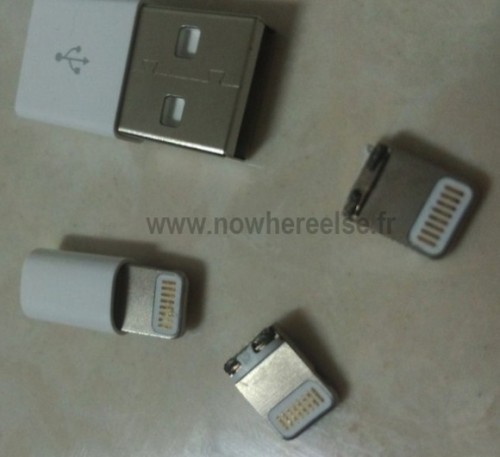
Accessory manufacturers also remain concerned over what technical and licensing restrictions Apple will be using with the new dock connector, as well as whether new circuitry will prevent their existing product from working with Apple's next-generation products even with an adapter.
Some accessory manufacturers have apparently been working hard to try to stay ahead of the competition, with a leaked micro-USB/Apple mini dock power adapter from Scosche showing up briefly earlier this week before the company requested that the images be removed. It is unclear how Scosche has been able to source new dock connector parts if Apple has not been working with accessory manufacturers, so it is unknown whether Scosche will have the parts in sufficient quantity to launch its accessories alongside or soon after the debut of the new iPhone.
Update 11:23 AM: iLounge's Jeremy Horwitz tells us that neither Scosche nor any other accessory manufacturer has access to the actual parts. They are all simply designing product based on their best guesses from what has leaked so far.
Last week, we shared photos of the leaked dock connector and headphone jack for the next-generation iPhone paired with a leaked rear shell for the device, demonstrating that the independently-obtained parts are indeed compatible and giving a good overview of what the bottom of the device will look like.
Sohu now posts (via Nowhereelse.fr) a new set of photos of parts for the next iPhone, including a photo showing a number of components placed into their proper positions within the rear shell. The flex cable housing the external buttons, the SIM tray, and dock connector/headphone jack flex cable can all be seen in the photo. Much of the remainder of the interior of the device will be taken up by the battery and logic board, which would be installed on the left and right sides respectively.

Parts repair firm iResQ published a set of photos with a similar theme earlier this week, installing the bare components into their proper positions in the rear shell.
The photos from Sohu also show an assembled front panel for the next-generation iPhone placed onto this partially assembled rear shell, giving a good look at the overall appearance of the device. Photos of a similar assembly appeared a month ago, but these new photos offer a fresh perspective on the complete device, comparing it to the iPhone 4 and 3GS and giving a good look at the comparative thickness of the three devices.

One final tidbit comes from iLab Factory, which posts a photo of the silver rear shell of the white next-generation iPhone but with black strips at the top and bottom for the antennas. All other photos of the rear shell from the white device seen to date have contained white strips.


 Reuters reports that Apple and several major publishers have agreed to offer concessions in an ongoing European Union antitrust investigation over alleged e-book price fixing. The concessions would significantly unravel the Apple-backed agency model of book pricing in which publishers set the retail prices for their content with distributors such as Apple and Amazon receiving a fixed percentage of the sales price.
Reuters reports that Apple and several major publishers have agreed to offer concessions in an ongoing European Union antitrust investigation over alleged e-book price fixing. The concessions would significantly unravel the Apple-backed agency model of book pricing in which publishers set the retail prices for their content with distributors such as Apple and Amazon receiving a fixed percentage of the sales price.
Regulators have claimed that the shift to the agency model amounted to price collusion facilitated by Apple and the publishers, sparking the antitrust concerns. For its part, Apple has cited that the implementation of the agency model has had the opposite effect, weakening Amazon's previously overwhelming position at the top of the market gained by selling books at deep discounts to entice customers to visit the online store and purchase other products and content.
While several observers have noted shortages of Apple's current 27-inch iMac at resellers over the past several months, the tight supplies now appear to be increasingly affecting Apple's own retail stores. According to a survey of retail store stock availability through the "Personal Pickup" program at Apple's 249 U.S. locations, each of the two standard 27-inch iMac configurations is currently out of stock at approximately half of all Apple retail stores.
Under the Personal Pickup program, customers can place their orders online and pick up the items at their local Apple retail stores. Most stock Mac configurations and many accessories are generally available for immediate pickup, but for items that are not in stock at a particular location, the company will ship the ordered items to the store for pickup within about a week.
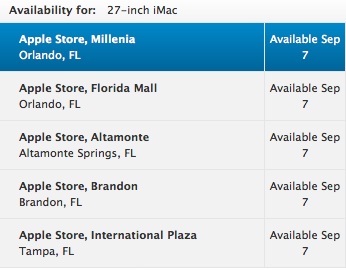
Our survey of Apple's retail stores shows that 120 out of the 249 U.S. locations are currently out of stock of the base 27-inch iMac model, with 135 locations being out of stock of the high-end configuration. Most of the stores are quoting a pickup date in the range of September 4-7, indicating that Apple will be able to deliver new orders for pickup fairly quickly, although some locations are quoting availability for as far out as September 11.
As with the shortages seen so far at resellers, Apple's shortages appear to be limited to the 27-inch models, with the 21.5-inch iMac continuing to be widely available at the company's retail stores. In our survey, we found only seven Apple retail store locations currently out of stock of the base 21.5-inch iMac model, all of which could offer pickup in the range of September 4-7.
Apple has been expected to release updated iMacs using Intel's latest Ivy Bridge processors at any time, with several reports having suggested that an October launch would be likely. One point of contention has been whether the new models will offer Retina displays, although the general consensus now seems to be that Apple will need to wait until next year for the higher-resolution displays to come to its desktop lineup.
Bloomberg reports that LG Display and AU Optronics will serve as suppliers for the 7.85-inch display destined for Apple's forthcoming "iPad mini". The publication specifically claims that the device will be released in October.

Interestingly, claims of LG and AU Optronics serving as suppliers for the iPad mini display can be traced all the way back to October 2011, when Taiwan's United Daily News claimed that the two companies had been sending samples to Apple. The Wall Street Journal reiterated the claim in February of this year.
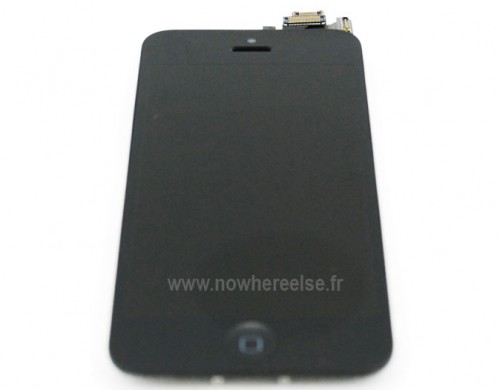
Reuters reports that Sharp's production of screens for the new iPhone is behind schedule. Sharp Corporation is one of three suppliers of the new displays.
Apple is expected to announced the new iPhone on September 12th.
Instapaper developer Marco Arment has spotted two new iPad device codes in his logs that he believes represents the long rumored "iPad mini".
The new identifiers found were "iPad2,5" and "iPad2,6". As Arment notes, the iPad2,1 through iPad 2,3 designations are known to represent the iPad 2's WiFi, GSM and CDMA models. The iPad2,4 represents a die-shrunk/cheaper version of the iPad 2 that was released alongside the 3rd generation iPad. Finally, the 3rd Generation iPad carries a designation of iPad3,x.
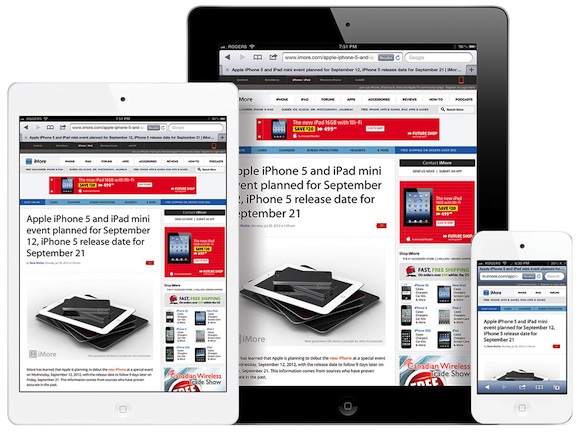
iPad Mini mockup (left) by iMore
As for "iPad2,5" and "iPad2,6", they have not been seen before, but Arment concludes they are likely to be the long rumored 'iPad mini' which is based on iPad 2 hardware.
Apple is believed to be launching a smaller 7.85" iPad in the coming months. Rumors have suggested we'll see it launched as early as October.
Apple has quietly made some changes to iOS 6's App Store app formatting tonight and introduced a new search results format that seem clearly inspired by Chomp.
Chomp was a three-year old search and app discovery startup that was acquired by Apple earlier this year. The reason for the acquisition was reportedly to improve the App Store search and app discovery. It appears the first of those efforts are being deployed in iOS 6.
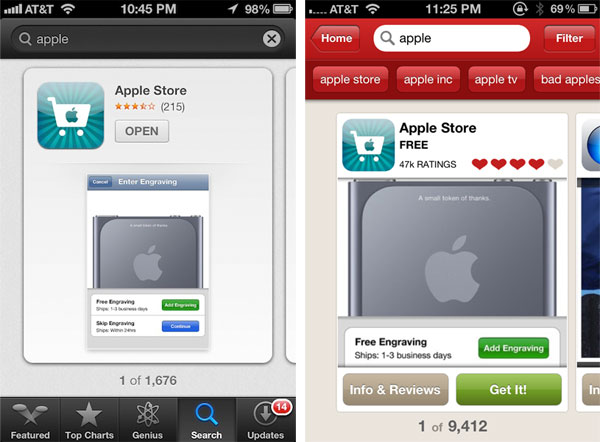 iOS 6 search results on left, Chomp app shown on right
iOS 6 search results on left, Chomp app shown on right
On the iPhone, the new search results show a single tile result that can be swiped to move to each new result. Chomp's iOS app used a similar tile system in their search results.
In a thread in our forums, some users are already unhappy with the shift as it is slower to browse through many results.
Meanwhile, 9to5Mac notes several other changes in App Store functionality such as Genius support, Purchased section and Podcast search:
 Adobe today provided a few more details on its plans for Retina display support on its software, noting that a Retina-compatible version of Photoshop CS6 will be arriving "this Fall". A Retina version of Lightroom 4 will also be delivered "as soon as the work is complete".
Adobe today provided a few more details on its plans for Retina display support on its software, noting that a Retina-compatible version of Photoshop CS6 will be arriving "this Fall". A Retina version of Lightroom 4 will also be delivered "as soon as the work is complete".
Adobe Photoshop was one of the high-profile applications highlighted by Apple at June's Worldwide Developers Conference as having Retina display support in the works. Adobe, Autodesk, and Blizzard were three major software companies Apple noted it had already been working with on Retina compatibility, but it is still taking some time for developers to make their applications fully compatible with the new ultra high-resolution display found on the Retina MacBook Pro.
Update 1:36 PM: A second blog post notes that Retina support will be coming to many more software titles than just Photoshop and Lightroom.
 The free, open-source image editor GIMP is now available for OS X as a native application. It is available for download from Gimp.org.
The free, open-source image editor GIMP is now available for OS X as a native application. It is available for download from Gimp.org.

 Earlier this week, we reported on a newly-disclosed vulnerability in Java SE 7 that could pose a risk for users on a wide variety of platforms, including OS X. While the real-world threat to Mac users stemming from the vulnerability is very low given that a Mac-specific exploit for the vulnerability has not been seen and only a small fraction of Mac users have manually installed Java SE 7, the incident has served as another reminder the Mac users can be vulnerable malicious attacks.
Earlier this week, we reported on a newly-disclosed vulnerability in Java SE 7 that could pose a risk for users on a wide variety of platforms, including OS X. While the real-world threat to Mac users stemming from the vulnerability is very low given that a Mac-specific exploit for the vulnerability has not been seen and only a small fraction of Mac users have manually installed Java SE 7, the incident has served as another reminder the Mac users can be vulnerable malicious attacks.
Although Oracle was reportedly warned of the issue months ago and apparently did not take significant action to protect users until it became public, the company has now moved quickly to address the problem with today's announcement regarding the release of Java SE 7 Update 7. The release addresses the specific vulnerability disclosed earlier this week as well as several others, and the company has also released Java SE 6 Update 35 to address a separate issue with the earlier version.
Reuters reports that Apple CEO Tim Cook and Google CEO Larry Page have been participating in active discussions to address patent issues relating to the two companies, "keeping the lines of communication open" as patent battles between Apple on one side and Google and its Android hardware partners on the other side continue to rage.
The two executives and their associates have reportedly been discussing some sort of settlement truce addressing some of the more minor issues that have been included in the disputes between the two companies. It is unclear, however, whether a broader agreement to address larger issues is also on the table.
Late last week, Apple was awarded over $1 billion in a jury verdict deciding that Samsung had infringed upon Apple's patents and trade dress with a number of its Android products. With Google's acquisition of Motorola Mobility, which has been involved in patent litigation with Apple for some time, Apple and Google are now also essentially competing head-to-head in the courts over these issues.
Apogee Electronics has long been one of the most highly-regarded manufacturers of professional audio equipment for Mac users, with the company's Duet 2 portable recording interface being one of its key products. The Duet 2 features dual inputs and an OLED display to help users make studio quality recordings in a wide variety of settings.
Apogee is now teasing an announcement for September 4 with the tagline "It's what you've been waiting four" hinting at a quad-input product. The partly shadowed image of the device on the teaser page appears to show a device larger than the Duet 2 but still carrying the same iconic controller knob seen on the company's portable interface boxes.

While full details on the product have yet to be revealed, the company appears to have briefly leaked an unmasked image of the device on its site yesterday. Controls on the box hint at four separate inputs, as well as some likely user-assignable touchpad keys as seen on the Duet 2.
A listing for the Apogee Quartet has appeared on Musician's Friend with a price of $1395 and an expected availability date of September 11.
The flood of part leaks claimed to be for the next-generation iPhone continues with a new report from Nowhereelse.fr [Google translation] pointing to a fresh set of high-quality photos and a video of an assembled front panel similar to the one that appeared earlier this week. The new photos and video come from Chinese parts distributor SINOCET.
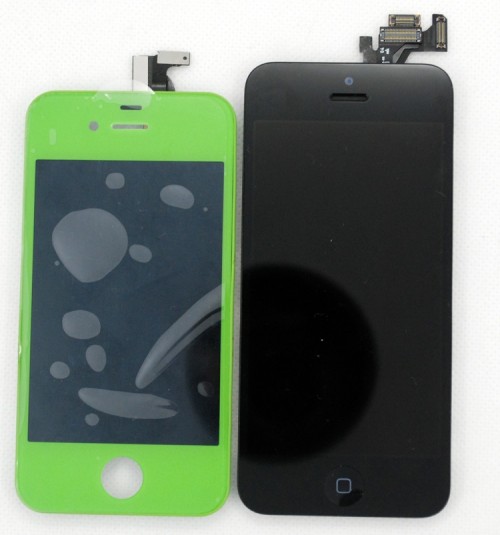
While the part isn't a new leak, the photos are of good quality and one shot in particular shows a front-on view of the assembled front panel next to the same part from an iPhone 4S, making clear how Apple has been able to minimize the overall increase in device height by shrinking the top and bottom margins somewhat to compensate for the impact of the taller screen. The height comparisons have been seen in previous leaks, but this new photo seems to shows the most straightforward comparison yet.
The video in the report also focuses on comparing the next-generation iPhone front panel assembly to the corresponding part from the iPhone 4S.
While a significant number of parts claimed to be for the next-generation iPhone have appeared over the past few months, the component of perhaps the most interest has yet to be seen: the main processor package. Speculation has covered a number of different possibilities including a die-shrunk A5 similar to that introduced in the revised iPad 2 earlier this year, an A5X such as found in the third-generation iPad, or an all-new A6 system-on-a-chip.
Several photos of the device's logic board have leaked in recent weeks but the low quality of the photos or the presence of shielding on the part have left the identities of the chips on the part unknown.
Sonny Dickson, who has been digging up photos of a number of components leaking out of Apple's supply chain, has now posted a partial photo of what certainly appears to be the same logic board part seen in previous photos. In this new photo, an "A6" designation can be seen on the main chip, suggesting that Apple may indeed be rolling out a brand-new chip family with the next-generation iPhone.

It is difficult to assess the validity of the photo, as the photo could rather easily have been faked and the image's small size and low quality make it impossible to determine the details of smaller text on the chip, but it does offer the first specific photo claim of the chip to be included in the next iPhone.
Update: 9to5Mac has posted the uncropped version of the photo showing the part with and without shielding.

Concerns do remain, however, over the legitimacy of the image.
If at any time you'd like to stop receiving these messages, just send an email to feeds_macrumors_com_macrumors_all+unsubscribe-minime2005=gmail.com@mail.feed2email.net.
To stop all future emails from feed2email.net you can reply to this email with STOP in the subject line. Thanks
Here's the latest feed from MacRumors: Mac News and Rumors - All Stories.

Add feeds@feed2email.net to your contact list to make sure you receive all your emails
Make sure to visit feed2email.net to get more feeds sent to your inbox.
To find out which feeds you are subscribed to, or to get further help, just reply to this email.
iOS Developer David Barnard: 'Trying to Make the Boxed Software Model Work at $0.99 is a Fool's Errand' [iOS Blog]
Aug 31, 8:19PM
iOS developer David Barnard has written an interesting piece on App Store pricing, and whether freemium is the inevitable pricing model for iOS apps, or if there is another model that hasn't been considered yet.
The full piece is worth a read for anyone involved in app development or marketing, but an excerpt is below.
I've argued that Apple caused the race to the bottom in App Store pricing, but now I'm starting to think that Apple just accelerated the inevitable. The App Store is by no means a free market, but it is an efficient one. Early on I was able to charge $9.99 for my app Trip Cubby, but now most people use free or cheaper alternatives, even though I dropped the price all the way to $2.99. The odd thing about paying a fixed, one-time price for software is that people who find the most value are essentially subsidized by people who pay, but don't end up liking/needing/using the app.
There's also the matter of value over time. As shown in this brilliant chart — created by the founder of Pocket, and inspired by the CEO of Evernote — paying a one-time, fixed price for something really only makes sense for commodities that diminish in value:

Barnard continues:
And that's exactly what we've seen in the App Store. People have no problem paying 99¢ for a gimmick, and don't mind risking 99¢ on an app whose value is unproven, but trying to make the boxed software model work at 99¢ a pop is a fool's errand. Sure, gimmicks and mass market apps like Camera+ seem to prove the opposite, but they are the outliers. The vast majority of apps are financial flops even though they deliver tremendous value to their niche.Barnard is the developer behind Launch Center Pro and other iOS apps.
And all of this brings us back to Sparrow. Most Mac and iOS users are content with Apple's free Mail apps, and of those who find Mail lacking, only a small percentage really care enough to spend money on an alternative. So, Sparrow was ultimately a very niche app. But as we saw in the days after Google acquired Sparrow, the niche it served found a lot of value in the app and were incredibly disappointed to see the app shelved. I'm still not sure how Sparrow could have empowered those who received more value to pay more for it, but developers who crack that nut are the ones who will still be making a living on apps in the years to come.
'MLB.com At Bat' Adds Support for Ford SYNC and Social Sharing Options [iOS Blog]
Aug 31, 7:12PM
Continuing its trailblazing efforts to deliver a great baseball viewing experience to iOS device owners, MLB Advanced Media has added Ford SYNC integration and social sharing with Facebook, Twitter, and email to its MLB.com At Bat app.

Ford SYNC is a Siri-esque integrated voice control system built into some Ford automobiles. The At Bat integration allows users to get scores, schedules, and live audio broadcast feeds using their voice.
At Bat 12 can be purchased for the remainder of the 2012 season for $9.99 (via in-app purchase), delivering out-of-market baseball games and home-and-away radio broadcasts for every game, including the postseason.
MLB At Bat is a free universal download from the App Store for iPhone and iPad. [Direct Link]
Walmart Testing iPhone-Based Self-Checkout System for Retail Stores
Aug 31, 6:51PM
Reuters reports that retail giant Walmart is currently testing a new "Scan & Go" service at one Arkansas store that allows iPhone users to scan items with their device as they shop and then proceed to a self-checkout station on their way out of the store to complete their purchase. The report points to a survey Walmart is using to gather feedback on the initiative.
We are conducting a study to assess the usability of the Walmart iPhone app's new Scan & Go feature. Scan & Go enables you to scan products with your phone and bag them while shopping in a Walmart retail store, and then use the Self-Checkout at the front of the store. This survey includes questions to help us determine if you qualify for an interview session. We are simply trying to get feedback from real people on whether this new system is user-friendly, and we think you will find participating in this study fun!

Walmart's test sessions were held earlier this week, with participants being compensated with a $100 payment and a $25 Walmart gift card for the one-hour sessions.
Details on how exactly the purchasing process works remain scant, but allowing users to scan their entire orders before approaching the checkout stand could in many cases result in significant time savings during busy shopping periods.
Video Demo of What a 4" iPhone Screen Looks Like in Action
Aug 31, 4:10PM
The biggest change in the rumored new iPhone is the increase in screen size from 3.5" to 4". As we've seen in numerous part leaks, the new iPhone screen will be taller, but not wider. This will give the new device a resolution of 1136x640 and provide apps with more vertical space to use. In fact, it's been found that iOS 6's home screen already supports this larger size to display an extra row of app icons.
In order to provide a better demonstration of what a 4" iPhone screen would feel like, MacRumors has had this video created to show it in action:
The video shows how the new 4" Home Screen would look. The extra space would naturally allow for larger app folder sizes. Games and other apps would have to be modified to take advantage of the extra real estate. We imagined, however, that existing apps would be "letterboxed", simply leaving empty black space at the top and bottom of the larger screen. Apple used a similar approach when supporting iPhone apps on the iPad.
The new 1136x640 resolution is almost exactly the same 16:9 ratio found on many widescreen monitors and televisions. This will fit many widescreen movies more naturally.
Some of the behavior in the video is speculative, but we believe it is likely representative of how a 4" iPhone would work. The evidence of such a screen has been overwhelming with part leaks and evidence of iOS support. Apple is expected to launch the new iPhone on September 12th.
Apple's Crowded Late 2012 Product Introduction Schedule Forced by Delays to iMac and iPad Mini
Aug 31, 4:03PM
KGI Securities analyst Ming-Chi Kuo has released a new research report outlining his thoughts on Apple's product introductions for the remainder of 2012, noting that delays in some necessary components have forced Apple into a very tight timeline that is less than ideal and which may impact growth over the short-term. The delays have affected several products, including the new "iPad mini" and an updated iMac.
Our survey shows that Apple will take the wraps off quite a few new products in September and October. From a marketing and sales point of view, too many new products in a short period of time is not a positive thing. An interval of at least two weeks between different products is needed; otherwise the promotional campaign will lack a clear focus and shopping line management will become overly complicated, not good for a satisfactory shopping experience. The good news is that we think Apple is well aware of the situation and is doing what it can to keep each new product's launch as isolated an event as possible.Recognizing that Apple is working to stagger its new product releases to ensure good visibility for each of them, Kuo has stretched out his estimated schedule from his report last month that saw nearly every product being introduced in September. Kuo now believes that the 13-inch Retina MacBook Pro and an updated 21.5-inch iMac could appear at any time, followed by the next-generation iPhone and iPod touch in mid-September. A tweaked full-size iPad and updated iPod nano would follow in early October, with the iPad mini and new 27-inch iMac later in October.

Kuo's report also walks through each of the products and highlights the production challenges that have forced Apple's hand on release dates.
On the iMac front, Kuo indicates that Apple will not be introducing Retina displays to the lineup this year, but that the company is working to fully laminate the current display panel to the cover glass for improved display quality. The process has proven to be challenging, and with lower yields on the 27-inch display than on the 21.5-inch panel, Kuo is modeling for sooner availability of the smaller model. We would naturally expect Apple to introduce both models at the same time, but the 27-inch may see either delayed availability or tight initial supplies as production on the panels ramps up.
Apple's work on the iPad mini has reportedly been slowed by the adoption of a thinner and lighter "GF Ditto" touch structure. Apple is said to be the first company in the world to commercialize and mass produce the technology, but equipment transitions and yield issues have reportdly forced Apple into its October launch for the device.
For the iPhone, he believes that Apple's suppliers should be able to offer sufficient supplies of the new in-cell display but that ramping has been slow due to some technical hurdles and logistics of packing the new display into a thinner body. Kuo predicts that the new iPod touch will adopt the same in-cell display technology and be released alongside the new iPhone, but that supplies could be constrained with priority for the new displays being given to the iPhone.
As for the iPod nano, Kuo believes that the device will indeed incorporate Wi-Fi connectivity as was rumored over the weekend and a revamped body with larger screen, but that issues with integrating the Wi-Fi chip into the revised iPod nano body will lead to a mid-October launch for the device.
Accessory Manufacturers Fear Missing Holiday Sales Rush as Apple Remains Mum on New iOS Device Dock Connector
Aug 31, 3:25PM
With a number of reports and now photos supporting the idea that Apple will be introducing a significantly smaller dock connector for its iOS devices in the coming weeks, iLounge reports that Apple's lack of advance notice is causing concern for accessory manufacturers worried that they will not be able to have new accessories ready in time for the lucrative holiday shopping season.
With only two weeks remaining before the expected debut of the next-generation iPhone, Apple has not offered third-party developers the components or engineering details necessary to build docking accessories for the new device—the first iOS product expected to ship without Apple's now-ubiquitous 30-pin Dock Connector, which will soon be replaced across all future Apple pocket and tablet devices. Noting the time required to manufacture and ship new products, the sources suggest that new iPhone-specific electronic add-ons will likely miss the upcoming holiday season, apart from whatever accessories are released by Apple itself.

Accessory manufacturers also remain concerned over what technical and licensing restrictions Apple will be using with the new dock connector, as well as whether new circuitry will prevent their existing product from working with Apple's next-generation products even with an adapter.
Some accessory manufacturers have apparently been working hard to try to stay ahead of the competition, with a leaked micro-USB/Apple mini dock power adapter from Scosche showing up briefly earlier this week before the company requested that the images be removed. It is unclear how Scosche has been able to source new dock connector parts if Apple has not been working with accessory manufacturers, so it is unknown whether Scosche will have the parts in sufficient quantity to launch its accessories alongside or soon after the debut of the new iPhone.
Update 11:23 AM: iLounge's Jeremy Horwitz tells us that neither Scosche nor any other accessory manufacturer has access to the actual parts. They are all simply designing product based on their best guesses from what has leaked so far.
Photos of Partially Assembled Next-Generation iPhone Show Component Layout, Thickness Comparison
Aug 31, 2:52PM
Last week, we shared photos of the leaked dock connector and headphone jack for the next-generation iPhone paired with a leaked rear shell for the device, demonstrating that the independently-obtained parts are indeed compatible and giving a good overview of what the bottom of the device will look like.
Sohu now posts (via Nowhereelse.fr) a new set of photos of parts for the next iPhone, including a photo showing a number of components placed into their proper positions within the rear shell. The flex cable housing the external buttons, the SIM tray, and dock connector/headphone jack flex cable can all be seen in the photo. Much of the remainder of the interior of the device will be taken up by the battery and logic board, which would be installed on the left and right sides respectively.

Parts repair firm iResQ published a set of photos with a similar theme earlier this week, installing the bare components into their proper positions in the rear shell.
The photos from Sohu also show an assembled front panel for the next-generation iPhone placed onto this partially assembled rear shell, giving a good look at the overall appearance of the device. Photos of a similar assembly appeared a month ago, but these new photos offer a fresh perspective on the complete device, comparing it to the iPhone 4 and 3GS and giving a good look at the comparative thickness of the three devices.

One final tidbit comes from iLab Factory, which posts a photo of the silver rear shell of the white next-generation iPhone but with black strips at the top and bottom for the antennas. All other photos of the rear shell from the white device seen to date have contained white strips.

Apple Offering Concessions in European E-Book Suit as Several Publishers Settle in U.S.
Aug 31, 2:19PM
Apple and four major publishers have offered to allow retailers such as Amazon to sell e-books at a discount for two years in a bid to end an EU antitrust investigation and stave off possible fines, a person familiar with the matter said on Friday. [...]News of Apple's willingness to make concessions in Europe comes just two days after a group of publishers agreed to a $69 million settlement in the United States over the same issue. The U.S. Department of Justice sued Apple and five publishers back in April, and while three of the publishers elected to settle the case, Apple and the other two publishers have been fighting the charges.
The Commission was now sounding out opinions from the industry as to whether the concessions are sufficient, the person familiar with the matter said, before a formal market test which could lead to the investigation being dropped.
Regulators have claimed that the shift to the agency model amounted to price collusion facilitated by Apple and the publishers, sparking the antitrust concerns. For its part, Apple has cited that the implementation of the agency model has had the opposite effect, weakening Amazon's previously overwhelming position at the top of the market gained by selling books at deep discounts to entice customers to visit the online store and purchase other products and content.
Shortages of 27-Inch iMacs Hitting Apple Retail Stores
Aug 31, 1:51PM
While several observers have noted shortages of Apple's current 27-inch iMac at resellers over the past several months, the tight supplies now appear to be increasingly affecting Apple's own retail stores. According to a survey of retail store stock availability through the "Personal Pickup" program at Apple's 249 U.S. locations, each of the two standard 27-inch iMac configurations is currently out of stock at approximately half of all Apple retail stores.
Under the Personal Pickup program, customers can place their orders online and pick up the items at their local Apple retail stores. Most stock Mac configurations and many accessories are generally available for immediate pickup, but for items that are not in stock at a particular location, the company will ship the ordered items to the store for pickup within about a week.

Our survey of Apple's retail stores shows that 120 out of the 249 U.S. locations are currently out of stock of the base 27-inch iMac model, with 135 locations being out of stock of the high-end configuration. Most of the stores are quoting a pickup date in the range of September 4-7, indicating that Apple will be able to deliver new orders for pickup fairly quickly, although some locations are quoting availability for as far out as September 11.
As with the shortages seen so far at resellers, Apple's shortages appear to be limited to the 27-inch models, with the 21.5-inch iMac continuing to be widely available at the company's retail stores. In our survey, we found only seven Apple retail store locations currently out of stock of the base 21.5-inch iMac model, all of which could offer pickup in the range of September 4-7.
Apple has been expected to release updated iMacs using Intel's latest Ivy Bridge processors at any time, with several reports having suggested that an October launch would be likely. One point of contention has been whether the new models will offer Retina displays, although the general consensus now seems to be that Apple will need to wait until next year for the higher-resolution displays to come to its desktop lineup.
LG and AU Optronics Once Again Named as Display Suppliers for 'iPad Mini' Coming in October [iOS Blog]
Aug 31, 1:24PM
Bloomberg reports that LG Display and AU Optronics will serve as suppliers for the 7.85-inch display destined for Apple's forthcoming "iPad mini". The publication specifically claims that the device will be released in October.
The orders will mark the first time AUO, a maker of panels for Apple's MacBooks and Sony Corp. TVs, is supplying screens for Apple handheld devices.The report also cites TPK and Foxconn subsidiary Yeh Chang Technology as handling the lamination coating for the display.
Carolyn Wu, a spokeswoman for Apple, declined to comment. Sharp Corp. may make panels for the device in the future and will not be an initial supplier, three of the people said.

Interestingly, claims of LG and AU Optronics serving as suppliers for the iPad mini display can be traced all the way back to October 2011, when Taiwan's United Daily News claimed that the two companies had been sending samples to Apple. The Wall Street Journal reiterated the claim in February of this year.
Sharp's Production of New iPhone Displays Reportedly Behind Schedule [iOS Blog]
Aug 31, 7:33AM

Reuters reports that Sharp's production of screens for the new iPhone is behind schedule. Sharp Corporation is one of three suppliers of the new displays.
Production of Sharp Corp's screens for Apple Inc's latest iPhone is behind schedule as the Japanese display maker struggles with low production yields, a source close to the matter told Reuters on Friday.Reuters offers no indication how severe the supply limitations are and if they will have an appreciable effect on the launch. As noted, Apple is also being supplied by Japan Display and LG Display Co for the new iPhone screens.
Apple is expected to announced the new iPhone on September 12th.
Possible 'iPad Mini' Spotted in iOS App Developer Logs
Aug 31, 4:47AM
Instapaper developer Marco Arment has spotted two new iPad device codes in his logs that he believes represents the long rumored "iPad mini".
The new identifiers found were "iPad2,5" and "iPad2,6". As Arment notes, the iPad2,1 through iPad 2,3 designations are known to represent the iPad 2's WiFi, GSM and CDMA models. The iPad2,4 represents a die-shrunk/cheaper version of the iPad 2 that was released alongside the 3rd generation iPad. Finally, the 3rd Generation iPad carries a designation of iPad3,x.

iPad Mini mockup (left) by iMore
As for "iPad2,5" and "iPad2,6", they have not been seen before, but Arment concludes they are likely to be the long rumored 'iPad mini' which is based on iPad 2 hardware.
The much more likely explanation is that iPad2,5 and iPad2,6 are the new "iPad Mini" in Wi-Fi and GSM, and I haven't recorded the likely iPad2,7 CDMA version yet.By "Gruber Display", Arment refers to John Gruber's speculation that a iPad Mini made sense as a 7.85" display that shares the same resolution as the original iPad (1024x768). Arment goes into a little further depth in his blog post about his speculation on the internals of the iPad mini.
If so, this suggests that the iPad Mini is, effectively, an iPad 2: an A5 with 512 MB of RAM and enough GPU power to drive the Gruber Display, but not a Retina Display.
It's a textbook Tim Cook supply-chain move: selling the last generation's hardware at a lower price point to expand marketshare.
Apple is believed to be launching a smaller 7.85" iPad in the coming months. Rumors have suggested we'll see it launched as early as October.
Apple Adds 'Chomp' Styled App Store Search Results and More in iOS 6
Aug 31, 3:48AM
Apple has quietly made some changes to iOS 6's App Store app formatting tonight and introduced a new search results format that seem clearly inspired by Chomp.
Chomp was a three-year old search and app discovery startup that was acquired by Apple earlier this year. The reason for the acquisition was reportedly to improve the App Store search and app discovery. It appears the first of those efforts are being deployed in iOS 6.
 iOS 6 search results on left, Chomp app shown on right
iOS 6 search results on left, Chomp app shown on rightOn the iPhone, the new search results show a single tile result that can be swiped to move to each new result. Chomp's iOS app used a similar tile system in their search results.
In a thread in our forums, some users are already unhappy with the shift as it is slower to browse through many results.
Meanwhile, 9to5Mac notes several other changes in App Store functionality such as Genius support, Purchased section and Podcast search:
Also adding to the iOS 6 App Store updates, Apple has enabled the Genius recommendation section this evening, providing users with apps that may be in their interest to download. Furthermore, the purchased section has also joined the party, displaying all the apps a user has downloaded to their account, making it easy to retrieve favorite apps. Last but certainly not least, the iTunes Store has been updated with the ability to once again search for podcasts.The iPad version of iOS 6 also shows the new tile-based results, but is able to show four results at a time. (screenshot).
Retina Display Support Coming to Photoshop CS6 and Lightroom 4 in 'Coming Months' [Updated]
Aug 30, 8:23PM
Supporting this new technology requires significant work by our product teams and we're committed to provided a free update to all Photoshop CS6 customers this Fall and Lightroom 4 as soon as the work is complete. Please note that Creative Cloud members will receive Photoshop updates more frequently and receive this update in advance of updates for non-members.Users of Photoshop Elements should not expect a Retina update in the immediate future, although that team is still looking into adding support for it.
Adobe Photoshop was one of the high-profile applications highlighted by Apple at June's Worldwide Developers Conference as having Retina display support in the works. Adobe, Autodesk, and Blizzard were three major software companies Apple noted it had already been working with on Retina compatibility, but it is still taking some time for developers to make their applications fully compatible with the new ultra high-resolution display found on the Retina MacBook Pro.
Update 1:36 PM: A second blog post notes that Retina support will be coming to many more software titles than just Photoshop and Lightroom.
We expect to update the following products with HiDPI support, free to all CS6 and Creative Cloud customers, over the next few months:
Dreamweaver
Edge Animate
Illustrator
Lightroom
Photoshop
Photoshop Touch
Prelude
Adobe Premiere Pro
SpeedGrade
We are currently evaluating the roadmap for when other products may support HiDPI displays, and we will announce those plans as they are finalized.
Open Source Image Editor GIMP Now Available as a Native OS X App [Mac Blog]
Aug 30, 8:16PM
 The free, open-source image editor GIMP is now available for OS X as a native application. It is available for download from Gimp.org.
The free, open-source image editor GIMP is now available for OS X as a native application. It is available for download from Gimp.org.GIMP is a popular and fairly powerful free image editor from the linux world that is basically like a freeware version of Photoshop, complete with many of the tools used for photo retouching and image manipulation that you'd expect. It's a great free PS alternative, but Mac users have long had to install X11 to get it to run. But not anymore! The newest version of Gimp for Mac OS X is bundled as a self-contained native app, that means no X11 installations, no Xcode, nothing but a simple dmg download.Previously, GIMP required the installation of X11, a windowing system for some specialized software -- something that is difficult for more inexperienced users to accomplish. Pixelmator is an excellent alternative image editor for most users, though it currently costs $15.
Oracle Releases Patch to Address Security Vulnerability in Java 7
Aug 30, 7:44PM
 Earlier this week, we reported on a newly-disclosed vulnerability in Java SE 7 that could pose a risk for users on a wide variety of platforms, including OS X. While the real-world threat to Mac users stemming from the vulnerability is very low given that a Mac-specific exploit for the vulnerability has not been seen and only a small fraction of Mac users have manually installed Java SE 7, the incident has served as another reminder the Mac users can be vulnerable malicious attacks.
Earlier this week, we reported on a newly-disclosed vulnerability in Java SE 7 that could pose a risk for users on a wide variety of platforms, including OS X. While the real-world threat to Mac users stemming from the vulnerability is very low given that a Mac-specific exploit for the vulnerability has not been seen and only a small fraction of Mac users have manually installed Java SE 7, the incident has served as another reminder the Mac users can be vulnerable malicious attacks. Although Oracle was reportedly warned of the issue months ago and apparently did not take significant action to protect users until it became public, the company has now moved quickly to address the problem with today's announcement regarding the release of Java SE 7 Update 7. The release addresses the specific vulnerability disclosed earlier this week as well as several others, and the company has also released Java SE 6 Update 35 to address a separate issue with the earlier version.
If successfully exploited, these vulnerabilities can provide a malicious attacker the ability to plant discretionary binaries onto the compromised system, e.g. the vulnerabilities can be exploited to install malware, including Trojans, onto the targeted system. Note that this malware may in some instances be detected by current antivirus signatures upon its installation.The updated versions of Java are available though Oracle's Java download page.
Tim Cook and Larry Page Working to Address Patent Issues Between Apple and Google
Aug 30, 6:18PM
Reuters reports that Apple CEO Tim Cook and Google CEO Larry Page have been participating in active discussions to address patent issues relating to the two companies, "keeping the lines of communication open" as patent battles between Apple on one side and Google and its Android hardware partners on the other side continue to rage.
Google Inc CEO Larry Page and Apple CEO Tim Cook have been conducting behind-the-scenes conversations about a range of intellectual property matters, including the ongoing mobile patent disputes between the companies, according to people familiar with the matter.
The two chief executives had a phone conversation last week, the sources said. Discussions involving lower-level officials of the two companies are also ongoing.

The two executives and their associates have reportedly been discussing some sort of settlement truce addressing some of the more minor issues that have been included in the disputes between the two companies. It is unclear, however, whether a broader agreement to address larger issues is also on the table.
Late last week, Apple was awarded over $1 billion in a jury verdict deciding that Samsung had infringed upon Apple's patents and trade dress with a number of its Android products. With Google's acquisition of Motorola Mobility, which has been involved in patent litigation with Apple for some time, Apple and Google are now also essentially competing head-to-head in the courts over these issues.
Apogee Preparing to Launch 'Quartet' Portable Audio Interface for Mac Music Professionals [Mac Blog]
Aug 30, 5:38PM
Apogee Electronics has long been one of the most highly-regarded manufacturers of professional audio equipment for Mac users, with the company's Duet 2 portable recording interface being one of its key products. The Duet 2 features dual inputs and an OLED display to help users make studio quality recordings in a wide variety of settings.
Apogee is now teasing an announcement for September 4 with the tagline "It's what you've been waiting four" hinting at a quad-input product. The partly shadowed image of the device on the teaser page appears to show a device larger than the Duet 2 but still carrying the same iconic controller knob seen on the company's portable interface boxes.

While full details on the product have yet to be revealed, the company appears to have briefly leaked an unmasked image of the device on its site yesterday. Controls on the box hint at four separate inputs, as well as some likely user-assignable touchpad keys as seen on the Duet 2.
A listing for the Apogee Quartet has appeared on Musician's Friend with a price of $1395 and an expected availability date of September 11.
New Photos and Video of 'iPhone 5' Front Panel Show Minimal Height Increase Over iPhone 4S
Aug 30, 5:01PM
The flood of part leaks claimed to be for the next-generation iPhone continues with a new report from Nowhereelse.fr [Google translation] pointing to a fresh set of high-quality photos and a video of an assembled front panel similar to the one that appeared earlier this week. The new photos and video come from Chinese parts distributor SINOCET.

While the part isn't a new leak, the photos are of good quality and one shot in particular shows a front-on view of the assembled front panel next to the same part from an iPhone 4S, making clear how Apple has been able to minimize the overall increase in device height by shrinking the top and bottom margins somewhat to compensate for the impact of the taller screen. The height comparisons have been seen in previous leaks, but this new photo seems to shows the most straightforward comparison yet.
The video in the report also focuses on comparing the next-generation iPhone front panel assembly to the corresponding part from the iPhone 4S.
Next-Generation iPhone to Use A6 System-on-a-Chip?
Aug 30, 1:34PM
While a significant number of parts claimed to be for the next-generation iPhone have appeared over the past few months, the component of perhaps the most interest has yet to be seen: the main processor package. Speculation has covered a number of different possibilities including a die-shrunk A5 similar to that introduced in the revised iPad 2 earlier this year, an A5X such as found in the third-generation iPad, or an all-new A6 system-on-a-chip.
Several photos of the device's logic board have leaked in recent weeks but the low quality of the photos or the presence of shielding on the part have left the identities of the chips on the part unknown.
Sonny Dickson, who has been digging up photos of a number of components leaking out of Apple's supply chain, has now posted a partial photo of what certainly appears to be the same logic board part seen in previous photos. In this new photo, an "A6" designation can be seen on the main chip, suggesting that Apple may indeed be rolling out a brand-new chip family with the next-generation iPhone.

It is difficult to assess the validity of the photo, as the photo could rather easily have been faked and the image's small size and low quality make it impossible to determine the details of smaller text on the chip, but it does offer the first specific photo claim of the chip to be included in the next iPhone.
Update: 9to5Mac has posted the uncropped version of the photo showing the part with and without shielding.

Concerns do remain, however, over the legitimacy of the image.
If at any time you'd like to stop receiving these messages, just send an email to feeds_macrumors_com_macrumors_all+unsubscribe-minime2005=gmail.com@mail.feed2email.net.
To stop all future emails from feed2email.net you can reply to this email with STOP in the subject line. Thanks
Comentários